Study of a High-Power Medium Frequency Transformer Using Amorphous Magnetic Material
Abstract
:1. Introduction
2. Optimization Design Method
2.1. Transformer Loss
2.1.1. Core Loss
2.1.2. Winding Loss
2.2. Transformer Volume
2.3. Optimal Loss and Area Product
2.4. Determination of Insulation and Winding
2.4.1. Insulation Design
2.4.2. Winding Design
3. Design Process for the MFT
4. Simulation and Experiment
4.1. Measurement of Magnetic Material Properties
4.2. Simulation Results and Analysis
4.3. Experimental Results
5. Conclusions
Author Contributions
Funding
Institutional Review Board Statement
Informed Consent Statement
Data Availability Statement
Conflicts of Interest
References
- Das, D.; Hrishikesan, V.M.; Kumar, C.; Liserre, M. Smart transformer enabled meshed hybrid distribution grid. IEEE Trans. Ind. Electron. 2020, 68, 282–292. [Google Scholar] [CrossRef]
- Huang, J.; Zhang, X.; Zhao, B. Simplified resonant parameter design of the asymmetrical CLLC-type DC transformer in the renewable energy system via semi-artificial intelligent optimal scheme. IEEE Trans. Power Electron. 2020, 35, 1548–1562. [Google Scholar] [CrossRef]
- Dragicevic, T.; Lu, X.; Vasquez, J.C.; Guerrero, J.M. DC microgrids—Part II: A review of power architectures, applications, and standardization issues. IEEE Trans. Power Electron. 2016, 31, 3528–3549. [Google Scholar] [CrossRef] [Green Version]
- Zhao, B.; Song, Q.; Liu, W.; Sun, Y. Overview of dual-active-bridge isolated bidirectional DC–DC converter for high-frequency-link power-conversion system. IEEE Trans. Power Electron. 2014, 29, 4091–4106. [Google Scholar] [CrossRef]
- Inoue, S.; Akagi, H. A bidirectional DC–DC converter for an energy storage system with galvanic isolation. IEEE Trans. Power Electron. 2007, 22, 2299–2306. [Google Scholar] [CrossRef]
- do Nascimento, V.C.; Moon, S.-R.; Byerly, K.; Sudhoff, S.D.; Ohodnicki, P.R. Multiobjective optimization paradigm for toroidal inductors with spatially tuned permeability. IEEE Trans. Power Electron. 2021, 36, 2510–2521. [Google Scholar] [CrossRef]
- Sarker, P.C.; Islam, M.R.; Guo, Y.; Zhu, J.; Lu, H.Y. State-of-the-art technologies for development of high frequency transformers with advanced magnetic materials. IEEE Trans. Appl. Supercond. 2019, 29, 7000111. [Google Scholar] [CrossRef] [Green Version]
- Zhao, B.; Song, Q.; Liu, W. A practical solution of high-frequency-link bidirectional solid-state transformer based on advanced components in hybrid microgrid. IEEE Trans. Ind. Electron. 2015, 62, 4587–4597. [Google Scholar] [CrossRef]
- Huber, J.E.; Kolar, J.W. Applicability of solid-state transformers in today’s and future distribution grids. IEEE Trans. Smart Grid 2019, 10, 317–326. [Google Scholar] [CrossRef]
- Bahmani, M.A.; Thiringer, T.; Rabiei, A.; Abdulahovic, T. Comparative study of a multi-MW high-power density DC transformer with an optimized high-frequency magnetics in all-DC offshore wind farm. IEEE Trans. Power Deliv. 2016, 31, 857–866. [Google Scholar] [CrossRef]
- Leibl, M.; Ortiz, G.; Kolar, J.W. Design and experimental analysis of a medium-frequency transformer for solid-state transformer applications. IEEE J. Emerg. Sel. Top. Power Electron. 2017, 5, 110–123. [Google Scholar] [CrossRef]
- Mogorovic, M.; Dujic, D. 100 KW, 10 KHz medium-frequency transformer design optimization and experimental verification. IEEE Trans. Power Electron. 2019, 34, 1696–1708. [Google Scholar] [CrossRef] [Green Version]
- Garcia-Bediaga, A.; Villar, I.; Rujas, A.; Mir, L.; Rufer, A. Multiobjective optimization of medium-frequency transformers for isolated soft-switching converters using a genetic algorithm. IEEE Trans. Power Electron. 2017, 32, 2995–3006. [Google Scholar] [CrossRef]
- Li, H.; Han, L.; He, B.; Yang, S. Application research based on improved genetic algorithm for optimum design of power transformers. In Proceedings of the Fifth International Conference on Electrical Machines and Systems—ICEMS’2001 (IEEE Cat. No.01EX501), Shenyang, China, 18–20 August 2001; Volume 1, pp. 242–245. [Google Scholar]
- Amoiralis, E.I.; Georgilakis, P.S.; Tsili, M.A.; Kladas, A.G. Global transformer optimization method using evolutionary design and numerical field computation. IEEE Trans. Magn. 2009, 45, 1720–1723. [Google Scholar] [CrossRef]
- Liang, Z.; Xie, B.; Li, R. A multi variable optimization design of high frequency transformer based on ALO algorithm. In Proceedings of the 2020 4th International Conference on HVDC (HVDC), Xi’an, China, 6–9 November 2020; pp. 670–675. [Google Scholar]
- Chen, B.; Liang, X.; Wan, N. Design methodology for inductor-integrated litz-wired high-power medium-frequency transformer with the nanocrystalline core material for isolated DC-link stage of solid-state transformer. IEEE Trans. Power Electron. 2020, 35, 11557–11573. [Google Scholar] [CrossRef]
- Rodriguez-Sotelo, D.; Rodriguez-Licea, M.A.; Soriano-Sanchez, A.G.; Espinosa-Calderon, A.; Perez-Pinal, F.J. Advanced ferromagnetic materials in power electronic converters: A state of the art. IEEE Access 2020, 8, 56238–56252. [Google Scholar] [CrossRef]
- Huang, P.; Mao, C.; Wang, D.; Wang, L.; Duan, Y.; Qiu, J.; Xu, G.; Cai, H. Optimal design and implementation of high-voltage high-power silicon steel core medium-frequency transformer. IEEE Trans. Ind. Electron. 2017, 64, 4391–4401. [Google Scholar] [CrossRef]
- Chen, D.; Cao, X.; Zhang, S.; Wang, Y.; Zhou, X.; Su, Z. Study of medium frequency transformer by using ultra-thin silicon steel sheet in DC-DC converter. IET Power Electron. 2022, 15, 789–801. [Google Scholar] [CrossRef]
- Zhang, P.; Li, L. Vibration and noise characteristics of high-frequency amorphous transformer under sinusoidal and non-sinusoidal voltage excitation. Int. J. Electr. Power Energy Syst. 2020, 123, 106298. [Google Scholar] [CrossRef]
- Johnson, F.; Hsaio, A.; Ashe, C.; Laughlin, D.; Lambeth, D.; McHenry, M.E.; Varga, L.K. Magnetic nanocomposite materials for high temperature applications. In Proceedings of the 2001 1st IEEE Conference on Nanotechnology. IEEE-NANO 2001 (Cat. No.01EX516), Maui, HI, USA, 30 October 2001; pp. 1–6. [Google Scholar]
- Costa, F.; Alves, F.; Benchabi, A.; Simon, F.; Lefèbvre, S. Design of a flyback transformer using a stress-annealed iron-based nanocrystalline alloy. Eur. Phys. J. AP 2002, 18, 173–180. [Google Scholar] [CrossRef]
- Hurley, W.G.; Wölfle, W.H. Transformers and Inductors for Power Electronics: Theory, Design and Applications; Wiley-Blackwell: Chichester, UK, 2013; ISBN 978-1-119-95057-8. [Google Scholar]
- Bergman, T.L.; Lavine, A.S.; Incropera, F.P.; Dewitt, D.P. Fundamentals of Heat and Mass Transfer, 7th ed.; Binder Version; Bergman, T.L., Incropera, F.P., Eds.; Wiley: Hoboken, NJ, USA, 2011; ISBN 978-0-470-91785-5. [Google Scholar]
- Steinmetz, C.P. On the Law of Hysteresis. Trans. Am. Inst. Electr. Eng. 1892, 9, 1–64. [Google Scholar] [CrossRef]
- Reinert, J.; Brockmeyer, A.; De Doncker, R.W.A.A. Calculation of losses in ferro- and ferrimagnetic materials based on the modified steinmetz equation. IEEE Trans. Ind. Appl. 2001, 37, 1055–1061. [Google Scholar] [CrossRef]
- Li, J.; Abdallah, T.; Sullivan, C.R. Improved calculation of core loss with nonsinusoidal waveforms. In Proceedings of the Conference Record of the 2001 IEEE Industry Applications Conference. 36th IAS Annual Meeting (Cat. No.01CH37248), Chicago, IL, USA, 30 September–4 October 2001; Volume 4, pp. 2203–2210. [Google Scholar]
- Venkatachalam, K.; Sullivan, C.R.; Abdallah, T.; Tacca, H. Accurate prediction of ferrite core loss with nonsinusoidal waveforms using only steinmetz parameters. In Proceedings of the 2002 IEEE Workshop on Computers in Power Electronics, Mayaguez, PR, USA, 3–4 June 2002; pp. 36–41. [Google Scholar]
- Shen, W. Design of High-Density Transformers for High-Frequency High Power Converters. Ph.D. Thesis, Virginia Polytechnic Institute and State University, Blacksburg, VA, USA, 2006. [Google Scholar]
- Orenchak, G.G. Estimating temperature rise of transformers. Power Electron. Technol. 2004, 30, 14–22. [Google Scholar]
- Ahmed, D.; Wang, L. Noniterative design of litz-wire high-frequency gapped-transformer (Lw-HFGT) for LLC converters based on optimal core-geometry factor model (OKGM). IEEE Trans. Ind. Electron. 2021, 68, 3090–3102. [Google Scholar] [CrossRef]
- Ortiz, G.; Biela, J.; Kolar, J.W. Optimized design of medium frequency transformers with high isolation requirements. In Proceedings of the IECON 2010—36th Annual Conference on IEEE Industrial Electronics Society, Glendale, AZ, USA, 7–10 November 2010; pp. 631–638. [Google Scholar]
- Li, J.; Water, W.; Zhu, B.; Lu, J. Integrated high-frequency coaxial transformer design platform using artificial neural network optimization and FEM simulation. IEEE Trans. Magn. 2015, 51, 8500204. [Google Scholar] [CrossRef] [Green Version]
- Barrios, E.L.; Ursua, A.; Marroyo, L.; Sanchis, P. Analytical design methodology for litz-wired high-frequency power transformers. IEEE Trans. Ind. Electron. 2015, 62, 2103–2113. [Google Scholar] [CrossRef]
- Shuai, P. Optimal Design of Highly Efficient, Compact and Silent Medium Frequency Transformers for Future Solid State Transformers. Ph.D. Thesis, ETH Zurich, Zurich, Switzerland, 2017. [Google Scholar]
- Rylko, M.S.; Lyons, B.J.; Hayes, J.G.; Egan, M.G. Revised magnetics performance factors and experimental comparison of high-flux materials for high-current DC–DC inductors. IEEE Trans. Power Electron. 2011, 26, 2112–2126. [Google Scholar] [CrossRef]


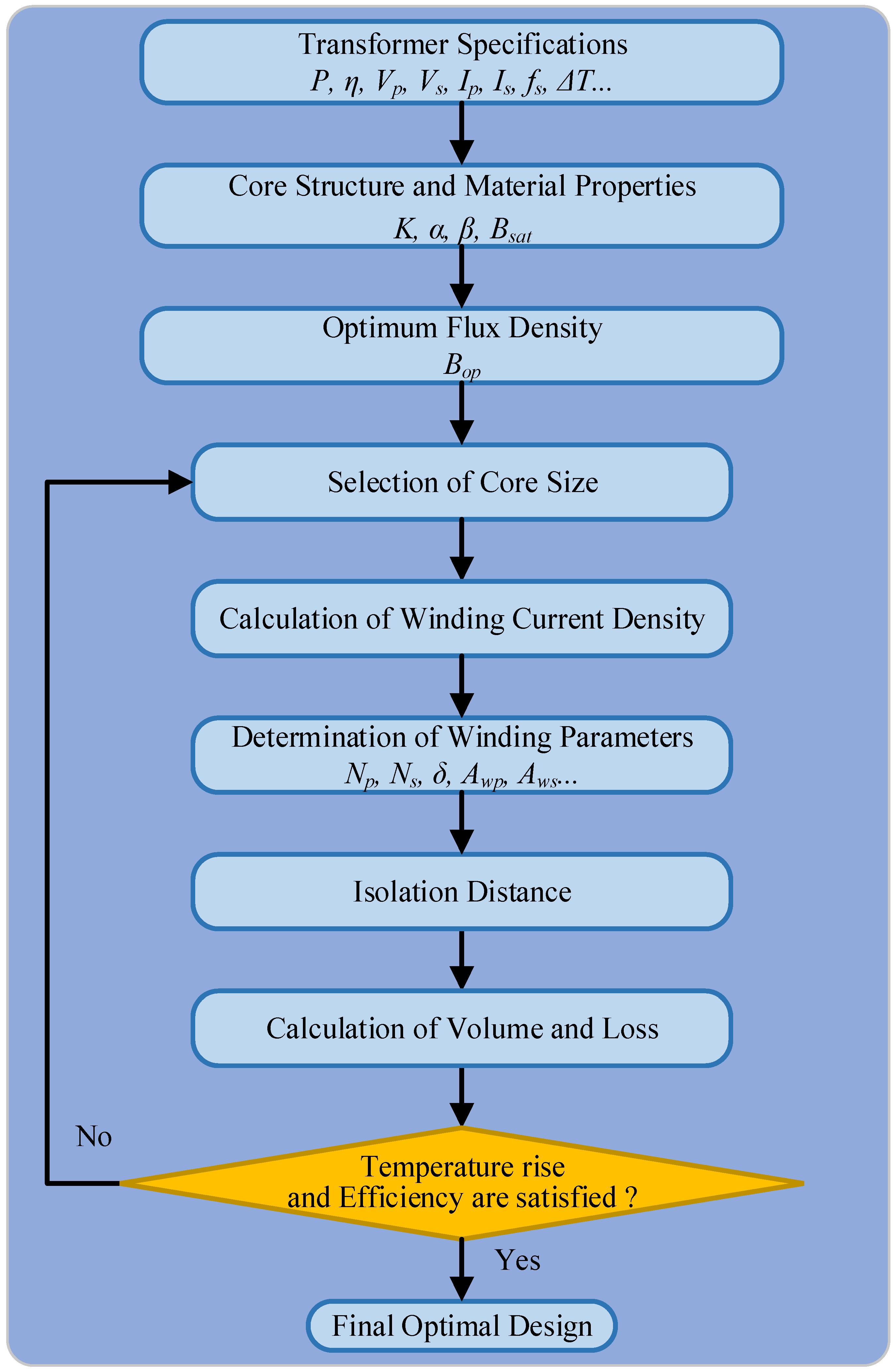
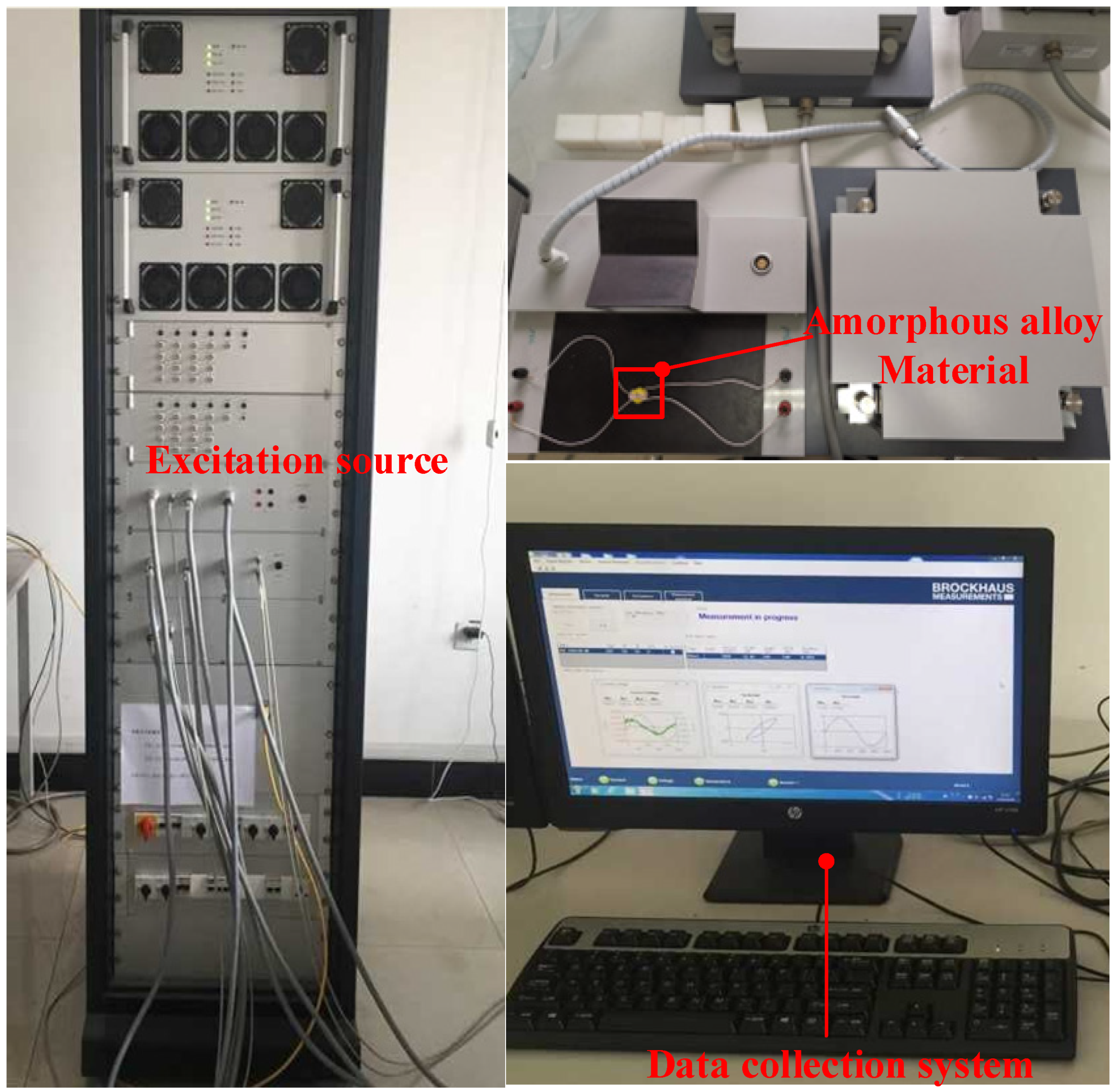

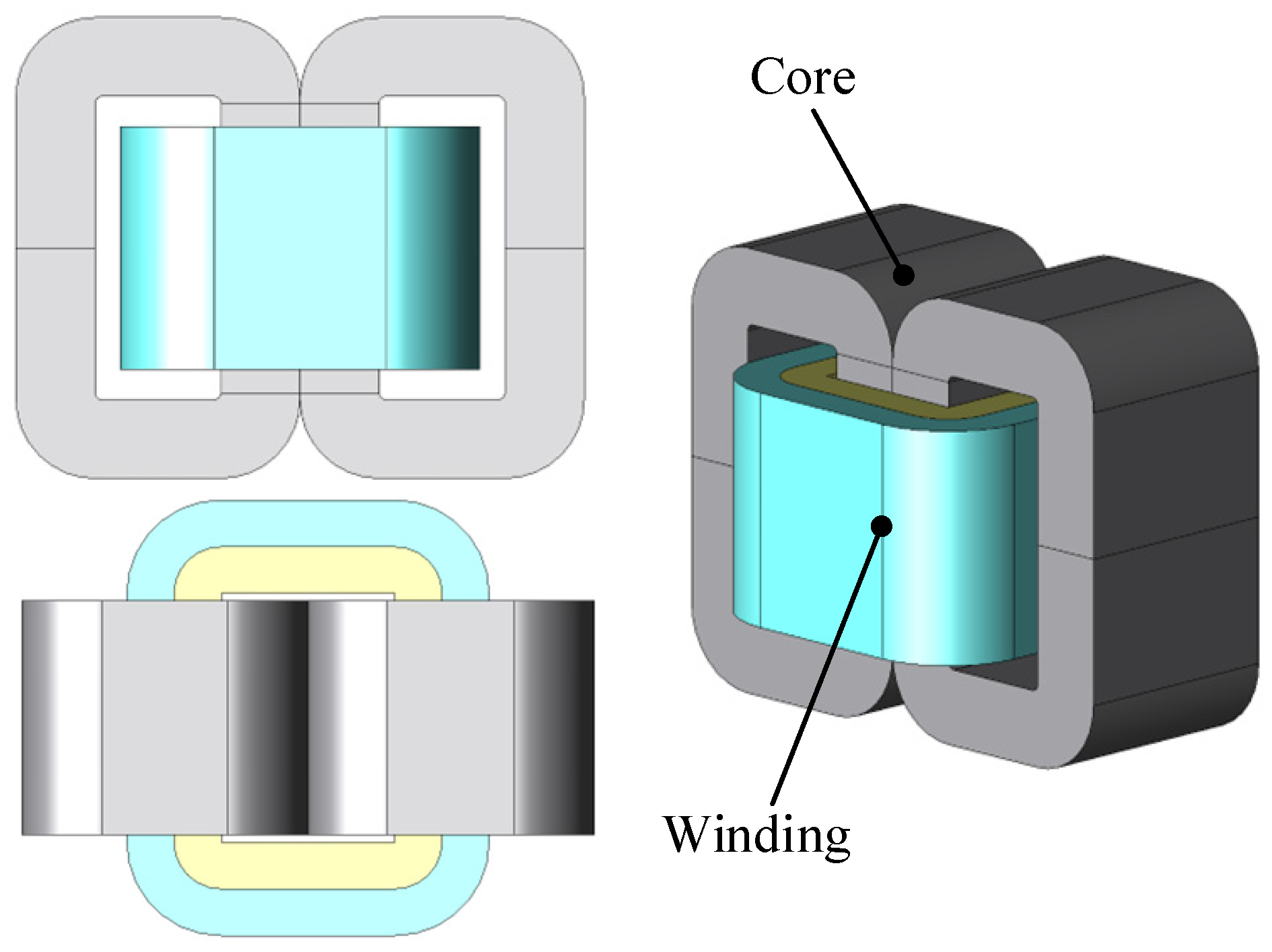
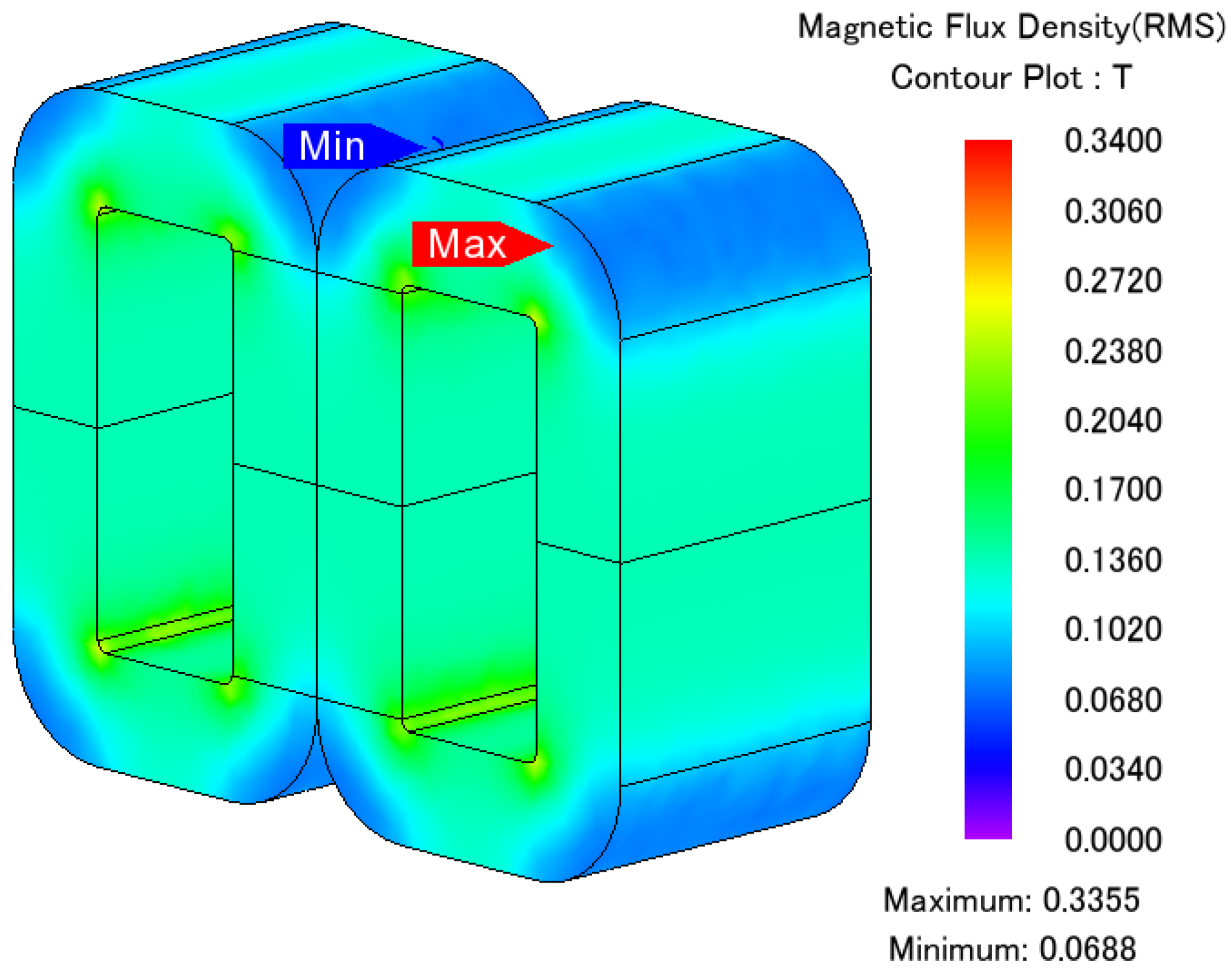
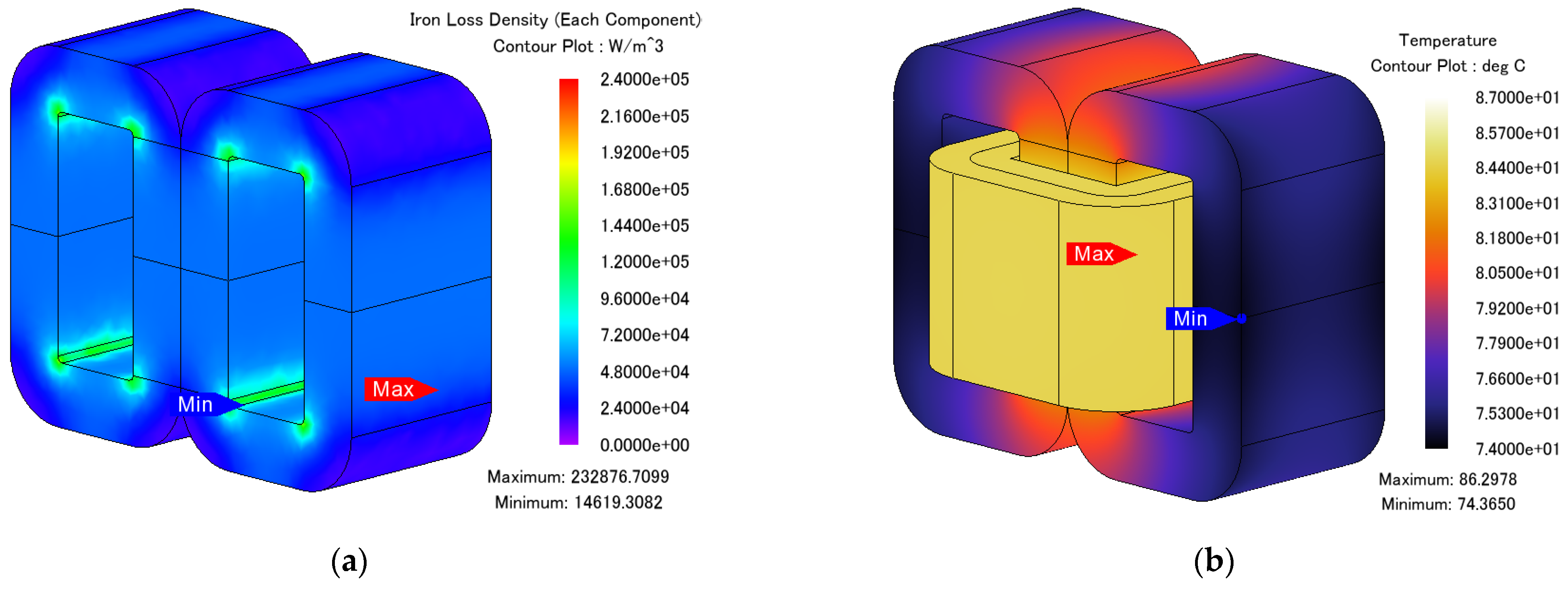
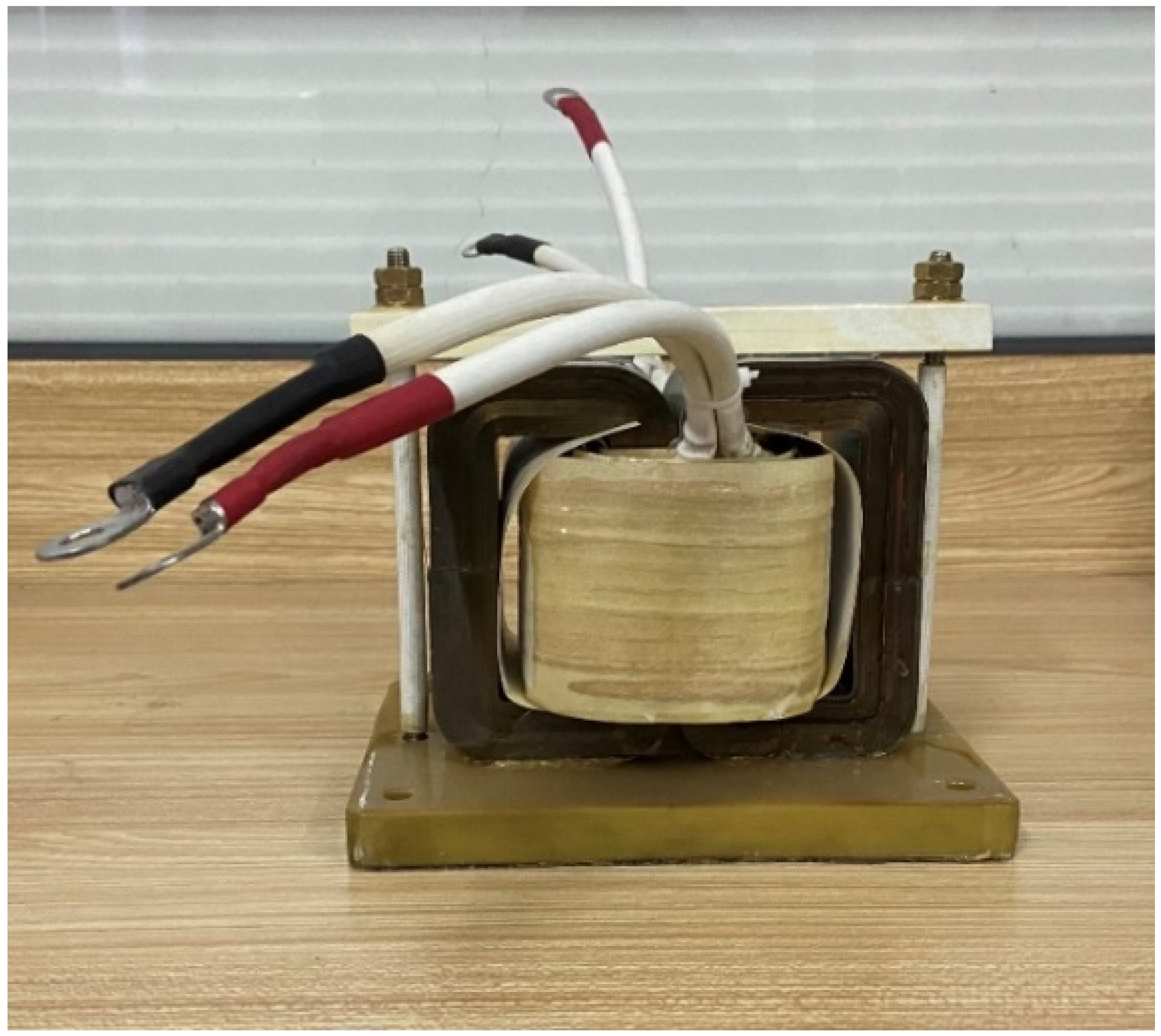
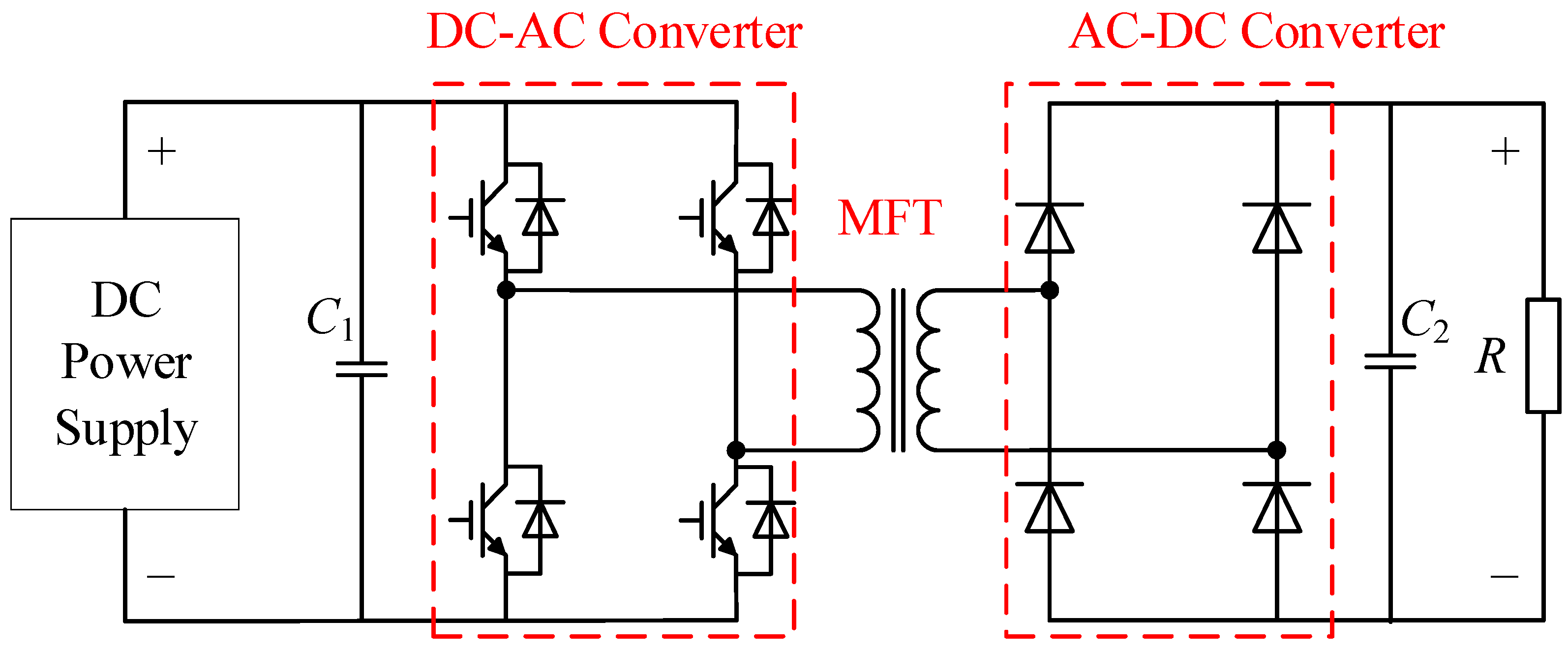


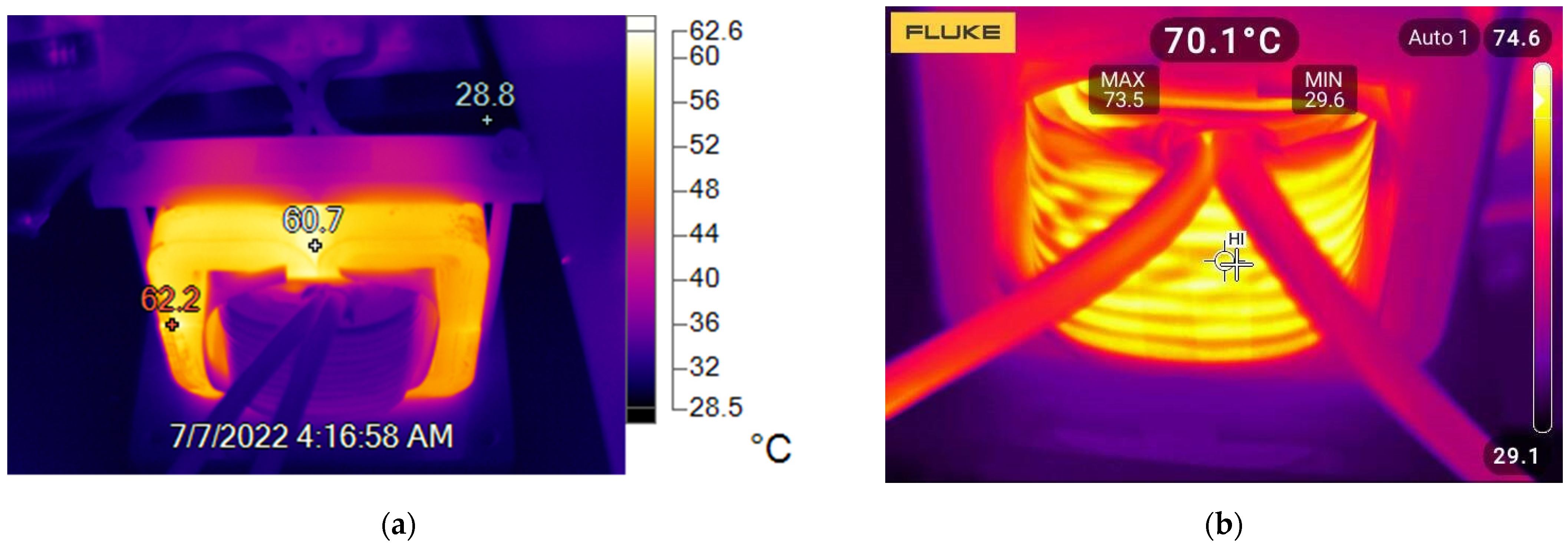
| Magnetic Material | Magnetic Flux Density @25 °C [T] | Operating Frequency [Hz] | Rel. Permeability (100 °C @20 kHz) | Curie Temperature [°C] | Density [g/cm3] | Core Loss @0.1 T, 20 kHz [kW/m3] | Core Fill Factor | Relative Cost |
|---|---|---|---|---|---|---|---|---|
| Ferrite Ferroxcube-3C93 | 0.52 | 1 M | 1800 | 240 | 4.8 | 5 | 1 | Low |
| Silicon Steel JFE-10JNHF600 | 1.88 | 0.05–1 k | 600 | 700 | 7.53 | 150 | 0.9 | Low |
| Amorphous alloy Metglas-2605SA1 | 1.56 | 0.4–150 k | 600 | 395 | 7.18 | 70 | 0.83 | High |
| Nanocrystalline alloy Vacuumschmelze-Vitroperm500F | 1.2 | 0.4–150 k | 13,200 | 600 | 7.3 | 5 | 0.7 | Very high |
| Parameter | Value |
|---|---|
| K | 1.3617 |
| α | 1.51 |
| β | 1.74 |
| Bsat | 1.5 T |
| Parameter | Variable | Value |
|---|---|---|
| Rated Power | P | 20 kW |
| Rated Frequency | fs | 10 kHz |
| Primary Voltage | Vp | 375 V |
| Secondary Voltage | Vs | 375 V |
| Turns radio | n | 1:1 |
| Temperature increase | ΔT | 70 °C |
| Parameter | Variable | Value |
|---|---|---|
| Core Material | Amorphous Alloy METGLAS 2605SA1 | |
| Core Type | Shell Type | |
| Core Dimensions | AMCC-400 | |
| Winding Wire Type | Litz Wire AWG36 | |
| Number of primary windings turns | Np | 18 |
| Number of secondary windings turns | Ns | 18 |
| Number of primary conductor strands | Sp | 1500 |
| Number of secondary conductor strands | Ss | 1500 |
| Core loss | Pfe | 34.7 W |
| Windings loss | Pcu | 45.4 W |
| Temperature increase | ΔT | 70 °C |
| Efficiency | η | 99.6% |
| Parameter | Winding Loss | Core Loss |
|---|---|---|
| Calculated | 45.4 W | 34.7 W |
| FEM simulation | 63.8 W | 42.1 W |
| Measured | 78.8 W | 56.2 W |
Publisher’s Note: MDPI stays neutral with regard to jurisdictional claims in published maps and institutional affiliations. |
© 2022 by the authors. Licensee MDPI, Basel, Switzerland. This article is an open access article distributed under the terms and conditions of the Creative Commons Attribution (CC BY) license (https://creativecommons.org/licenses/by/4.0/).
Share and Cite
Zhang, S.; Chen, D.; Bai, B. Study of a High-Power Medium Frequency Transformer Using Amorphous Magnetic Material. Symmetry 2022, 14, 2129. https://doi.org/10.3390/sym14102129
Zhang S, Chen D, Bai B. Study of a High-Power Medium Frequency Transformer Using Amorphous Magnetic Material. Symmetry. 2022; 14(10):2129. https://doi.org/10.3390/sym14102129
Chicago/Turabian StyleZhang, Shichong, Dezhi Chen, and Baodong Bai. 2022. "Study of a High-Power Medium Frequency Transformer Using Amorphous Magnetic Material" Symmetry 14, no. 10: 2129. https://doi.org/10.3390/sym14102129
APA StyleZhang, S., Chen, D., & Bai, B. (2022). Study of a High-Power Medium Frequency Transformer Using Amorphous Magnetic Material. Symmetry, 14(10), 2129. https://doi.org/10.3390/sym14102129






